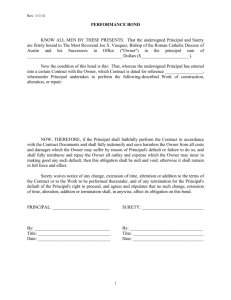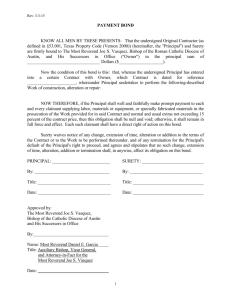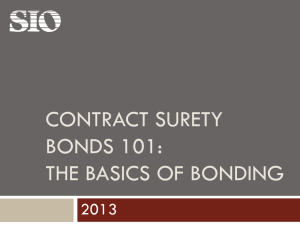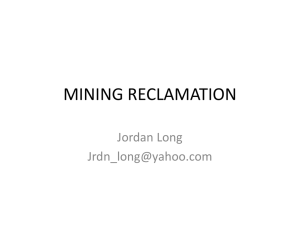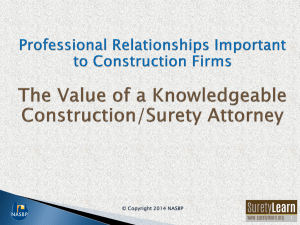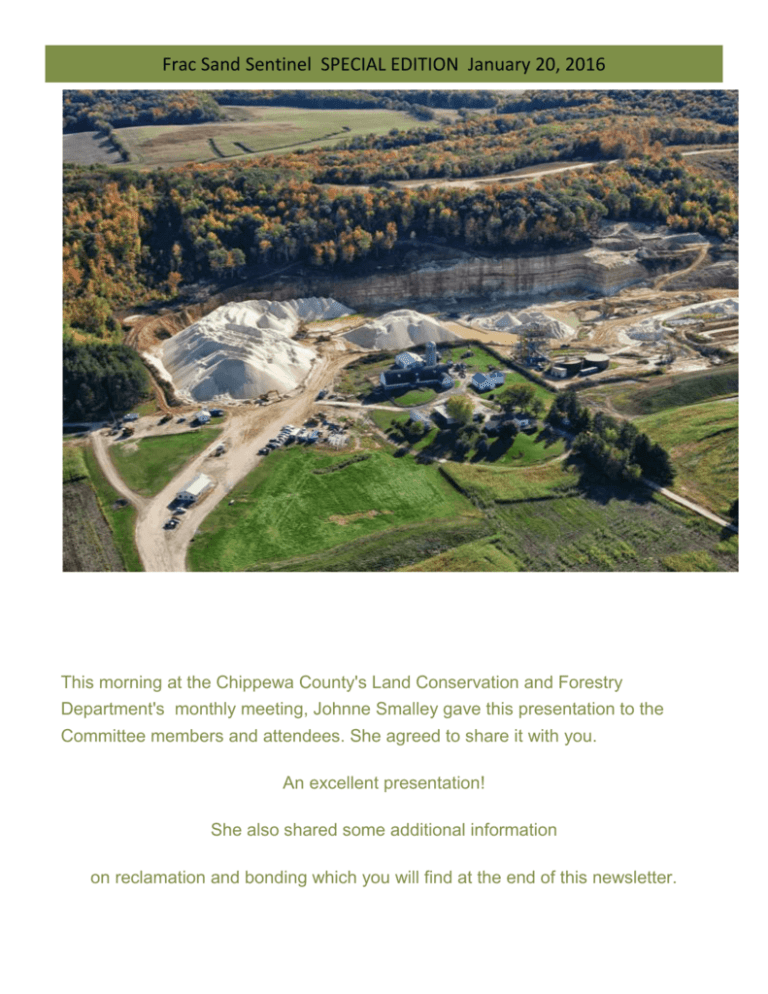
Frac Sand Sentinel SPECIAL EDITION January 20, 2016
This morning at the Chippewa County's Land Conservation and Forestry
Department's monthly meeting, Johnne Smalley gave this presentation to the
Committee members and attendees. She agreed to share it with you.
An excellent presentation!
She also shared some additional information
on reclamation and bonding which you will find at the end of this newsletter.
My name is Johnne Smalley. I own and pay taxes on land in Wheaton Township in Chippewa County.
I am here today to find out what Chippewa County envisions for its future.
I have read Chippewa County’s Comprehensive Plan, but I don’t see the county following it. Page 173,
Section 6.4 states:
Goal 1 - Maintain the physical condition, biodiversity, ecology, and environmental functions of the
landscape, including its capacity for flood storage, groundwater recharge, water filtration, plant growth,
ecological diversity, wildlife habitat, and carbon sequestration.
Goal 2 - Maintain the capacity of the land to support productive forests and agricultural working lands to
sustain food, fiber, and renewable energy production.
How many acres of land have been removed from productive forests and agricultural working lands to
support frac sand mines owned by and operated for the financial benefit of people that are not from our
area, often not even from our state, and sometimes, not even from our country?
How have all these frac sand mines maintained the physical condition, biodiversity, ecology, and
environmental functions of the landscape, including its capacity for flood storage, groundwater recharge,
water filtration, plant growth, ecological diversity, wildlife habitat, and carbon sequestration? What I’m
seeing is a bunch of eyesores scarring our land, devastation of forested hillsides, businesses that were
dependent on tourist trade closing, increased costs for agricultural businesses dependent on rail transport
of fertilizers into the area and corn out of the area, decreased wildlife habitat resulting in increased crop
destruction as the wildlife relocate into adjacent cropland, and tons of colloidal clay from their ponds
washing into our trout streams and ruining the trout habitat. There are toxic levels of silica 2.5 dust in the
air which affect our health and probably animal health. In other localities near frac sand facilities,
veterinarians have noticed increased fertility problems including a significant lower conception rate and
higher rate of stillborn and weak calves. There have been similar reports by farmers near mine sites in
Chippewa County. Coincidence?
I’m also seeing a tremendous increase in the number of homes for sale around these sites and at greatly
reduced prices. Some people have given up and just walked away from their home to move elsewhere.
Now I am seeing the approval of another reclamation permit for a 1300+ acre frac sand mine, processing
plant, and trans-load station. This permit has been granted to a company with a known history of
disregarding DNR regulations that protect our groundwater from contamination.
I have also read a good bit of The Chippewa County Code of Ordinances.
The Chippewa County Code of Ordinances Chapter 30, Sec. 106 lines 741-744 states:
“Sec. 30-106. Permit denial. An application for a nonmetallic mining reclamation permit shall be denied if
any of the factors specified in Wis. Admin. Code NR § 135.22 exist.
NR 135.22 Denial of application for reclamation permit, clearly states, “An application to issue a
nonmetallic mining reclamation permit shall be denied if
(c) 1. The applicant, or its agent, principal or predecessor has, during the course of nonmetallic mining in
Wisconsin within 10 years of the permit application or modification request being considered shown a
pattern of serious violations of this chapter or of federal, state or local environmental laws related to
nonmetallic mining reclamation.”
Northern Sands, LLC has more than 20 DNR violations of inappropriate exploratory borehole
abandonments in Chippewa County. Leaving holes open can create a direct conduit for entry of
contaminants to waters of the state and is a serious violation of ch. 281, Wisconsin Statutes and ch.
NR812, Wis. Adm. Code. (Just ask anyone who has to drink water from an aquifer that has had liquid
manure dumped down a hole into it).
The proposed post−mining land use given in 3.0 of the Howard Township Properties Nonmetallic Mine
Reclamation Plan “include a combination of commercial and passive recreational uses....Approximately
eighty-five percent of the site will be reclaimed as prairie grasslands: approximately fifteen percent of the
area will be reclaimed as woodland.” The Chippewa County Land Conservation and Forest Management
staff can explain better than I can that prairie grasslands are not the same as productive agricultural
cropland that sustain food, fiber, and renewable energy production. (See goal 2 from Chippewa County’s
Comprehensive Plan as quoted above.)
NR 135 also states, “The proposed post−mining land use shall be consistent with local land use plans.” In
addition, State law Sec.66.1001. Wis. Stats. requires that local land use-related decisions be consistent
with the goals and objectives of that community’s comprehensive plan. I am not seeing how taking more
and more productive cropland and forest away to return it to native prairie “maintains the capacity of the
land to support productive forests and agricultural working lands to sustain food, fiber, and renewable
energy production”.
I would also like to question why Chippewa County is not requiring an independent expert or consultant to
do the monitoring and reporting of this mine site with reimbursement costs paid back to the county by
Northern Sands. This permit allows Northern Sands to do their own checking and reporting. Their history
has shown how well they have done that in the past. On multiple occasions, their actions and reports
have been fabricated and falsely reported to both the Howard Town Board and the Wisconsin
DNR. Having county personnel or even state personnel checking to make sure the monitoring and
reporting is being done accurately is just adding to the taxpayers’ burden. With Northern Sands history,
they will need close oversight and this cost should fall back onto Northern Sands—not the taxpayers.
An agency-designated consultant with recognized experience in the areas of financial assurance and
reclamation should also be required to evaluate any financial assurance given by Northern Sands with the
costs incurred paid by Northern Sands. Reclamation Surety Bonds for other mining endeavors have
proved inadequate in the past. Repeatedly, the Surety Bonds have been for inadequate amounts. They
may cover the cost of reclamation as outlined, but usually fail to cover any problems that may occur—
especially the cost of re-working an area where reclamation failed and the cost of pollution cleanup. Also, there is a history of Surety Bond issuers failing when it comes time for the actual
reclamation. In some instances there has been a close tie between the surety bond company and the
mine owner.
In conclusion, I would like to repeat my question of how the Chippewa County envisions its future and
how its actions in permitting these frac sand mines support this vision.
Thank you.
Johnne added some additional comments regarding her research. She says she has other materials she
would be willing to share if there is someone concerned about the financial aspects of reclamation.
In researching the problems associated with Reclamation Surety Bonds, I have
found:
a. Most reliable Surety Bond companies do not do surety bonds for
reclamation. The nature of what surety bonds do and what reclamation
is make them incompatible. A Surety bond is for a set period of time,
while reclamation will not be completed until some unknown date in the
future.
b. The companies that do provide Surety Bonds for reclamation are often
not reliable. Past history has shown that they will provide a bond for a
set period of time both initially and with each renewal, but refuse
renewal when actual reclamation is near at which time they may
disappear, dissolve, or declare bankruptcy.
c. The Bureau of Land Management no longer considers Surety Bonds an
adequate source of financial assurance for reclamation of mines
permitted by them.
d. Most Surety Bonds are for inadequate amounts. They only consider
the cost of reclamation if everything goes well. They do not cover the
cost of any reclamation failure. Reclamation failures have in the past
bankrupted many companies providing the bond. This is one of the
major reasons why many local, state and federal governments no
longer consider surety bonds an adequate form of financial assurance
for reclamation.
I will give website information to different documentation describing the problems
with reclamation surety bonds from state regulators’, surety bond industry’s, mining
association, and lawyers’ points of view. A few key points, I will list below.
According to David Ganje of Ganje Law Offices in Rapid City (practicing in the area
of natural resources, environmental and commercial law)
in http://www.lexenergy.net/south-dakotas-first-in-situ-leach-uranium-
mining-project/
“My concern with any large natural resource project is the risk of socializing the expense
of any possible environmental cleanup as a cost paid by the taxpayer. “Superfund” is a
federal environmental law under which the government supervises cleanup of
contaminated mining and industrial sites. The polluter is financially responsible for the
cleanup. However about 30 percent of Superfund sites are orphaned sites where no
responsible party is available to pay for cleanup. Without adequate financial assurance
terms in place by a mine operator to pay for a possible cleanup, the taxpayer may have to
step in to pay.
A mine operator’s financial capacity comes into play in the matter of abandoned mines,
orphaned mines, spills, costs of water reclamation, decontamination and closure or
decommissioning of a mine. Many mine operators address financial assurance
requirement by using surety bonds. A surety bond is an insurance company’s guarantee
of an applicant’s performance under a permit. An applicant must prove adequate financial
resources for reclamation, spills and final closure. Nevertheless several mining
operations in the US have been closed with unresolved environmental and groundwater
issues exceeding the costs of the financial assurances posted for the operation.”
According to Kellan McLemore, Staff Attorney, Midwest Environmental
Advocates, “There is already a history in Wisconsin of mining companies
bailing on their reclamation commitments prior to completion of reclamation.”
According to “Mine Reclamation Bonding – from Dilemma to Crisis to Reinvention: What’s a
State Regulator to Do?” Presented by Gregory E. Conrad Executive Director Interstate Mining
Compact Commission Before the Energy and Mineral Law Foundation Winter Workshop on
Energy Law February 11,
2014 http://www.imcc.isa.us/EMLF%20Bonding%20Presentation%20Final.pdf
“traditional surety bonds, or similar instruments, were never designed for long-term reclamation
obligations like water treatment but instead were focused on shorter term and very defined
obligations that had a high certainty for eventual release following the completion of reclamation
(generally based on success of revegetation of the site). Ordinarily, bonding underwriters will not
provide a surety bond if it is determined that a site will have long-term pollutional discharges
since the bond will likely never be released – an outcome that a bonding company will do its best
to avoid. This is largely because reclamation bonds, unlike insurance, are intended to function
primarily as credit transactions or accommodations in which the surety anticipates no loss.”
And
“Over the course of the past 35 years since the enactment of the Surface Mining Control and
Reclamation Act of 1977 (SMCRA)2, bonding (or financial assurance)3 programs related to the
reclamation of coal mining operations have undergone a series of adjustments that reflect the
changing nature of both the coal and surety industries. Some changes have involved small
refinements; others represent new, innovative approaches that were not on anyone’s radar
screen in the early days of SMCRA’s implementation. In many respects, the bonding program
under SMCRA has served as a microcosm of the larger financial and economic challenges faced
by the country as a whole, beginning with the “bonding dilemma” of the mid-90’s when bankrupt
surety companies and under-funded bond pools caused great concern, to the “bonding crisis” of
the early 2000’s as the surety and insurance industries responded to the significant losses
associated with 9/11 and catastrophic weather events, to the “bonding challenges” that we face
today as a result of corporate restructuring and unanticipated environmental conditions and
priorities, especially related to water quality and long-term treatment scenarios. ... There are a
variety of other issues that the states are currently working through in the bonding arena and
many of these were discussed at three recent workshops that IMCC hosted for state regulatory
authorities. Beyond those mentioned above, states are also focused on bond forfeitures,
especially those associated with bankruptcies and the potential for alternative enforcement;
tracking letters of credit as a result of bank mergers and closures; difficulties associated with
updating and increasing bond amounts; the expense associated with full cost bonding;
insufficient funds following bond forfeitures; and the increasing complexity of administering a
bonding program, especially with regard to risk analysis.”
Gregory Conrad states, “Representing as I do the states that regulate the mining industry, my
views are admittedly from the perspective of a state government agency, whose primary interest
is to ensure that the state will have sufficient funds to complete the reclamation should the
operator default and to thereby protect the citizens and taxpayers of the state from being saddled
with unfunded liabilities. It is this same interest that has motivated several federal government
agencies to develop or propose robust financial assurance programs where mineral extraction is
concerned, including the Bureau of Land Management9, the U.S. Forest Service and the U.S.
Environmental Protection Agency.”
According to RECLAMATION BONDS FROM THE SURETY PERSPECTIVE
Presented By William T. Gorton III, Esq.,
(https://www.bestlawyers.com/Downloads/Articles/2267_1.pdf)
“The negotiations with the regulatory agencies, surface and mineral owners and
other interested parties can create a very complicated scenario that requires an
understanding of the law regarding environmental protection, bankruptcy and
suretyship, along with technical expertise in land reclamation. Though presented in
the context of the coal industry, the principles discussed below are generally
applicable to the mining industry as a whole. ... Until the recent surge in coal
prices, numerous companies with large coal mine environmental obligations have
been dissolved or become bankrupt in the last ten years including most recently,
Horizon Natural Resources, Lodestar Energy, LTV Steel, Bethlehem Steel, AEI
Resources, Quaker Coal, Pen Holdings, Anker Energy and others. In such an
event, notwithstanding a potential successful reorganization, coal operations that
have stopped in mid-operation become "problem mines," and may be subject to
bond forfeiture for various reasons. Under SMCRA, the regulatory agency must
notify the permittee and surety of its intent to forfeit the bonds and advise of
conditions under which forfeiture may be avoided. By this time, however, it is
usually very late in the game for the surety to be able to have significant influence
over its bonded principal.” ... Many of the most complicated matters facing the
regulatory agencies and sureties have involved the large company bankruptcies or
dissolutions with numerous sites involving all aspects of mining. ... The surety is
not the permittee and is not subject to permitting requirements as is an operator.
Many of the larger cases are also subject to U.S. Bankruptcy Court jurisdiction
therefore the surety, permittee and agencies must deal with a Trustee or Debtor in
Possession and other creditors. Most real legal conflicts occur here due to the
intersection of environmental law, surety law and bankruptcy law. There are
inherent competing interests: Goals of bankruptcy law: return funds to creditors.
According tohttp://corporate.findlaw.com/business-operations/mining-and-thevanishing-surety-bond-market.html
Financial Distress in the Surety Industry
“In the congressional hearings during the summer of 2002, the president of the
Surety Association of America (SAA), Lynn Schubert, testified that a report
released by SAA in May 2002 provides evidence of the potentially devastating
conditions facing the surety bond industry.... These problems have been
accompanied by a shrinking supply of surety companies due to mergers,
bankruptcies, and unilateral decisions by surety providers to leave the business.
According to one source, the availability of surety is constrained due to the
presence of fewer surety companies than in the past. Reportedly, five of the twelve
largest surety providers were acquired or exited the business between 1998 and
2001. The impacts of the recent events on surety providers similarly have affected
the reinsurance market. In order to limit financial exposure, surety companies
historically have entered into agreements with reinsurance providers. For example,
a surety company may contractually agree to be liable for a percentage or
predetermined amount of the bond liability with any additional amounts covered by
the reinsurer. If the bond is forfeited, the reinsurer is typically liable for the agreed
upon dollar amount to the surety provider and not to the beneficiary of the bond. ...
the unique circumstances related to the extractive industry have curtailed
dramatically the availability of sureties for mining companies now as compared to
the 1990s. In particular, the mining industry's ability to obtain financial guarantees
is directly affected by the duration of the surety commitment, the downturn in the
market for minerals, recent regulatory changes, and the changing surety industry.
First, in contrast to most non-mining projects, the obligations related to mining
reclamation often are of indefinite duration and can extend for decades or longer.
Regulators increasingly have responded to this long-term exposure to risk by a
wariness to release any portion of a surety as reclamation is performed. Delay in
bond release provides further evidence to surety companies that the duration of
risk is highly uncertain, and thus makes them less willing to provide new or
increased surety to the mining industry.”
http://faculty.lawrence.edu/gerardd/wpcontent/uploads/sites/9/2014/02/22-RP-Gerard-bonding.pdf
Abstract:
It is becoming a standard practice for governments to require mining operations to
post reclamation bonds. Yet, there have been few theoretical treatments examining
the rationale for bonding mechanisms, and even fewer empirical treatments of the
effectiveness of bonding. This paper addresses some of these holes in the
literature. It begins by examining the rationale underlying reclamation bonds, and
discusses the strengths and weaknesses of bonding as a tool for enforcing
reclamation requirements. The role of bonding mechanisms is to help enforce
standards, not necessarily yield efficient outcomes, and these mechanisms are
best viewed as a complement to — not a substitute for — liability rules. The paper
also examines the effectiveness of bonding by drawing on evidence from hardrock
mining on public lands in the western United States.
2001 Elsevier Science Ltd.
All rights reserved.
Problems with bonding mechanisms.
There are several problems associated with bonding mechanisms that limit their
applicability (Shogren et al., 1993). First and foremost, bonding is not free — the
firm, the regulator, and the surety each incur transaction costs. These transaction
costs increase as uncertainty increases or as contracting becomes more complex,
as complex contracts are costly to write, interpret, and enforce. For instance, a
contract that specifies that “reasonable efforts must be taken to reclaim the site”
would be likely to be much more difficult to enforce than one that specified brightline rules for reclaiming drill holes, roads, processing facilities, and the like. As
contracting becomes more costly, the effectiveness of the bonding mechanism
decreases. Uncertainty is also a primary impediment to the smooth operations of
liability rules. Therefore, it is unlikely that the bonding mechanism will be an
effective substitute for liability rules. A second problem is that bonds can impose
liquidity constraints on firms. Cash, treasury bonds, certificates of deposit, and
other liquid assets are often acceptable forms of collateral, but these instruments
can tie up a firm’s operating capital. This liquidity constraint becomes more binding
as the deposit amount increases. One way to mitigate the liquidity constraint is by
involving a third party, for instance, a surety. For a fee, a surety agrees to cover
the amount of the bond if the agent fails to fulfill its obligation, which also transfers
a portion of the default risk from the public to the surety provider (there is not
necessarily a transfer of funds that the landowner holds in trust; instead, the surety
assumes a legal obligation to provide funds if the firm reneges on its agreement).
The use of a surety reduces, but does not eliminate, liquidity constraints. The firm
must pay an annual premium, and the bond amount is also a liability on the firm’s
balance sheet that adversely affects the firm’s credit. Although collateral reduces
the firm’s moral hazard, it also introduces moral hazard on the side of the
regulator. A wealth-maximizing regulator may have the incentive to retain the bond
whether or not reclamation is performed. This is a potentially serious defect of the
bonding mechanism. If, however, the operating permit specifies reclamation
requirements that can be verified by a third-party at a low cost, the firm should be
able to successfully challenge the regulator’s decision. Moreover, it would be
difficult for a state with a poor reputation to attract capital to its jurisdiction, and
surety pro- viders would be less likely to underwrite contracts for operations within
that state.
Based on past history of mining reclamation and the problems state and federal
agencies have reported with surety bonds, I question whether Chippewa County
has the staff resources to conduct adequate review of financial assurance issues?
NRC (Nuclear Regulatory Commission) officials told us that their staff resources
are limited and that they lack the financial expertise to evaluate compliance with
investment restrictions. . .The federal watchdog agency General Accountability
Office (GAO) expressed concern over the BLM and NRC’s ability to determine the
costs of reclamation. At the very least, I would like to suggest that Chippewa
County follows the advice of David Ganje of Ganje Law Offices in Rapid City
(practicing in the area of natural resources, environmental and commercial law).
Whether the financial assurance is in the form of a surety bond, escrow account or
any other form, the agency with designated authority over an applicant’s financial
assurance requirements shall evaluate in writing all financial assurance
documentation using an agency-designated non-party (Consultant) with
recognized experience in the areas of financial assurance. This designation shall
be a condition of any permit or license. The costs incurred by the agency in
contracting with the Consultant shall be paid by the applicant.
If any of this information can be used by anyone else in the battle against frac sand
mines, please feel free to use it. I also have a copy of a 2005 Consent Order and
Agreement showing that a regulated surety company had $500,000 less cash
available than the $4.3M in reclamation guarantees it had written for a mine
operatorwhere the surety company was closely affiliated with the mine operator.
This is not a normal reason for surety bond failures but it does show that this does
happen.
Hope this is useful.
Johnne Smalley

